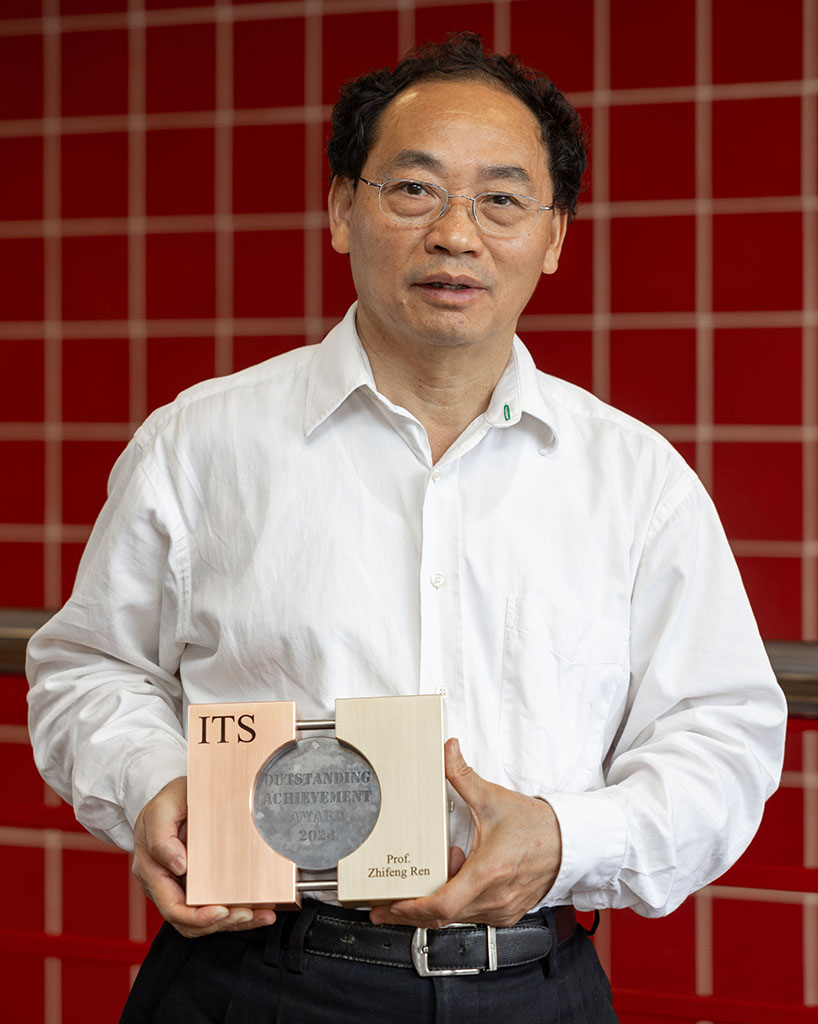Prestigious Award Recognizes Achievement in Scholarship and Service to Thermoelectrics Community
Zhifeng Ren of the University of Houston is the recipient of the 2024 Outstanding Achievement in Thermoelectrics Award presented by the International Thermoelectric Society (ITS). The award recognizes outstanding achievement in scholarship and service to the thermoelectrics community and is the highest recognition for researchers in the field.

Ren, the Paul C.W. Chu and May P. Chern Endowed Chair in Condensed Matter Physics and director of the Texas Center for Superconductivity at UH (TcSUH), is noted for his pioneering research in thermoelectric materials synthesis by nanostructuring to reduce thermal conductivity and improve thermoelectric properties for waste heat conversion into electricity and cooling using electrical power.
The award, initiated in 2011, includes a cash prize of $5,000 and grants honorary membership in the ITS. The recipient receives a one-of-a-kind trophy—a medal engraved out of the thermoelectric SiGe alloy (award's middle circle) and copper-based electrodes (award's left and right sides) that produced electrical power from radioisotope-produced heat to power the deep space missions since the 1960s.
Professor Takao Mori, ITS President, said Ren’s selection was based on his outstanding research contributions to the field.
Among the 630 published papers and 73 issued patents the Ren group has accomplished, there are more than 250 papers and 30 patents on thermoelectric materials and devices. In thermoelectrics, their first breakthrough came in 2008 when the thermoelectrics community was still struggling, significantly enhancing the thermoelectric performance of bulk bismuth antimony telluride via a nanostructure approach realized by ball milling and hot pressing.
The work, published in Science 320(5876), 634-638 (2008), was considered a milestone because the thermoelectric performance of the exact material had not been increased for over 50 years. The easy-to-adapt nanostructure approach by ball milling and hot pressing was immediately implemented by thousands of scientists worldwide to either improve the existing thermoelectric materials or discover new materials.
As a result of Ren’s research program, over the last 23 years, 25 students have graduated with Ph.D. degrees in thermoelectrics. More than 50 postdoctoral fellows and visiting scholars have come out of his group and are making outstanding contributions to the thermoelectric field. He hopes to have the same luck during the next 23 years and expects even better achievements.
Ren’s research career to date has focused heavily on thermal conductivity, the measure of a material’s ability to conduct heat at either very low (less than 2 Watts per meter per Kelvin) for better thermoelectric performance and many other applications or very high like what has been achieved in boron arsenide (higher than 1500 Watts per meter per Kelvin) for better thermal management. In addition to the ultrahigh thermal conductivity, boron arsenide also has ultrahigh charge carrier mobility, much higher than silicon and gallium arsenide, the two most used semiconductors in our daily lives: electronics, cell phones, and computers. The unexpectedly ultrahigh thermal conductivity and carrier mobility in boron arsenide are promising to revolutionize future electronics, especially high-power electronics.
Multiple organizations, including the Materials Research Society, the American Physical Society, the American Association for the Advancement of Science, and the National Academy of Inventors, have widely recognized Ren’s work. He was also highly ranked among the world’s top 100 materials scientists for the decade 2000-2010.
The award was presented in the auditorium of a salt mine 135 meters below the ground on July 3, 2024, in Krakow, Poland, at the joint 40th International and 20th European Thermoelectric Conference, supported by the ITS and the European Thermoelectric Society. Ren gave the Award Lecture covering some of his most impactful work during the past 23 years on July 4.
- Susan Butler, Texas Center for Superconductivity at UH